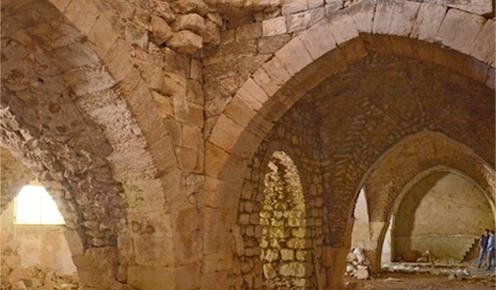"As early as 603 AD, Pope Gregory I commissioned the Ravennate Abbot Probus, who was previously Gregory's emissary at the Lombard court, to build a hospital in Jerusalem to treat and care for Christian pilgrims to the Holy Land. After that developments continued.
In 800, Emperor Charlemagne enlarged Probus' hospital and added a library to it. About 200 years later, in 1009, Caliph Al Hakim destroyed the hospital and three thousand other buildings in Jerusalem.
In 1023, merchants from Amalfi and Salerno in Italy were given permission by the Caliph Ali az-Zahir of Egypt to rebuild the hospital in Jerusalem. The hospital, which was built on the site of the monastery of Saint John the Baptist, took in Christian pilgrims travelling to visit the Christian holy sites. It was served by Benedictine monks.
The monastic hospitaller order was founded following the First Crusade by the Blessed Gerard, whose role as founder was confirmed by the papal bull Pie Postulatio Voluntatis issued by Pope Paschal II of 15 February 1113. The Pope subordinated the hospital to his own authority and exempted it from paying tithes on the lands it owned, and gave the right to its professed brothers to elect their master. Gerard acquired territory and revenues for his order throughout the Kingdom of Jerusalem and beyond.
Under his successor, Raymond du Puy de Provence, the original hospice was expanded to an infirmary near the Church of the Holy Sepulchre in Jerusalem. Around this time the Hospital of St John became connected with that Church, and documents often referred to "the Holy Sepulchre and the Hospital of St John of Jerusalem. Initially the group cared for pilgrims in Jerusalem, but the order soon extended to providing pilgrims with an armed escort, which soon grew into a substantial force. Thus the Order of St. John imperceptibly became military without losing its charitable character. The Hospitallers and the Knights Templar became the most formidable military orders in the Holy Land. Frederick Barbarossa, the Holy Roman Emperor, pledged his protection to the Knights of St. John in a charter of privileges granted in 1185.
In 1023, merchants from Amalfi and Salerno in Italy were given permission by the Caliph Ali az-Zahir of Egypt to rebuild the hospital in Jerusalem. The hospital, which was built on the site of the monastery of Saint John the Baptist, took in Christian pilgrims travelling to visit the Christian holy sites. It was served by Benedictine monks.
The monastic hospitaller order was founded following the First Crusade by the Blessed Gerard, whose role as founder was confirmed by the papal bull Pie Postulatio Voluntatis issued by Pope Paschal II of 15 February 1113. The Pope subordinated the hospital to his own authority and exempted it from paying tithes on the lands it owned, and gave the right to its professed brothers to elect their master. Gerard acquired territory and revenues for his order throughout the Kingdom of Jerusalem and beyond.
Under his successor, Raymond du Puy de Provence, the original hospice was expanded to an infirmary near the Church of the Holy Sepulchre in Jerusalem. Around this time the Hospital of St John became connected with that Church, and documents often referred to "the Holy Sepulchre and the Hospital of St John of Jerusalem. Initially the group cared for pilgrims in Jerusalem, but the order soon extended to providing pilgrims with an armed escort, which soon grew into a substantial force. Thus the Order of St. John imperceptibly became military without losing its charitable character. The Hospitallers and the Knights Templar became the most formidable military orders in the Holy Land. Frederick Barbarossa, the Holy Roman Emperor, pledged his protection to the Knights of St. John in a charter of privileges granted in 1185.
The Israel Antiquities Authority (IAA) announced the finding of the 1000-year-old building of the Hospitallers in the Christian Quarter of the Old City of Jerusalem. The building was spread out over more than 14.000 square metres and characterized by massive pillars, ribbed vaults, smaller halls, patient rooms and ceilings as high as 6 metres. “The Muslim Arab population was instrumental in assisting the Crusaders in establishing the hospital and teaching them medicine,” the IAA archaeologists said. It was the Muslim hero Salah a-Din, who conquered Jerusalem from the Crusaders (1187, TN), who helped preserve the structure, allowing ten Crusader monks to run the hospital.
Historical documents have revealed that the hospital was highly organised with different wings and departments for patients suffering from different medical conditions. In times of emergency, it could take in up to 2,000 patients from all religions. There was even a system ensuring Jewish patients to receive kosher food.
In the earthquake of 1457, the building collapsed. During the Ottoman Empire, what remained was used as a fruit and vegetable market that operated until 2000."
Source Wikipedia and Order of Malta; Illustration source
Support TemplarsNow™ by becoming a Patron, tipping us or buying one of our Reliable Books

No comments:
Post a Comment